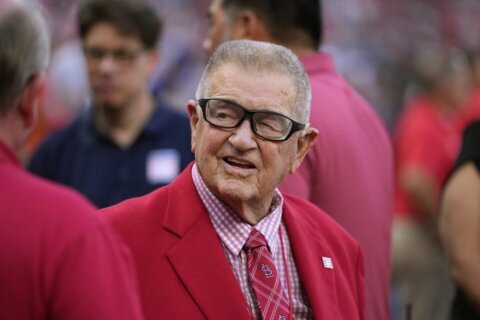WASHINGTON — There’s an old joke that involves a wealthy woman who pulls up to a swanky hotel in a Cadillac and asks the bellhop to carry her adult son from the car into the hotel. Asked why her son can’t just walk in, she says, “He can, but thank goodness he doesn’t have to.”
I’m reminded of that joke by a report that the baseball bullpen car may be making a comeback. According to Phil Rogers of the Chicago Tribune, players have suggested bringing it back to help speed up the game.
There was a time when relief pitchers were brought in from the bullpen in a car or some form of a modified golf cart. Depending on the team, the bullpen vehicle also served as a moneymaker. As a kid going to Senators games at RFK Stadium in the 1960s and early ‘70s, I saw relievers arrive in a red Corvette convertible sponsored by Sport Chevrolet.
I asked my dad why they couldn’t just walk in from the “pen,” just past center field, and I don’t remember getting a great answer. It really seemed silly when you consider pitchers, even then, used running drills to stay in shape. Would a stroll in from the bullpen really tire a pitcher out?
It’s not like it was part of the tradition of the grand old game. Major league baseball dates back to 1869, decades before Henry Ford started rolling cars off the assembly line. It seems, according to Paul Lukas, who tracks these kind of things for ESPN.com, the bullpen car dates back to 1950 when the Cleveland Indians, owned by famed showman Bill Veeck, started using a little red car to drive pitchers to the mound. Other teams followed using cars, but it was the Milwaukee Braves who were not only the first known National League team to use bullpen transport but took it to another level.
On June 23, 1959, visiting pitcher Hal Jeffcoat of the St. Louis Cardinals was delivered to the mound by a driver with a chauffeur’s uniform on a Harley-Davidson Topper scooter. Never mind being driven by car to the warning track along the third-base line — the scooter could be driven across the grass and directly to the mound. No walking required.
It seemed to work well for the Braves, not so much for the Jeffcoat and the Cardinals. Bob Wolf wrote that day in the Milwaukee Journal Sentinel: “All Jeffcoat got for his trouble was the distinction of being the first ride in the Braves’ new bullpen perambulator. He was bashed for 11 hits and six runs, and left under heavy fire in the sixth.”
By the 1970s, most teams had bullpen vehicles, which were starting to roll up the miles. During the decade, relief specialists became a bigger part of baseball and the strategy involved. Before that, only pitchers that were getting shelled were pulled for relievers, and nobody kept track of pitch counts.
Sparky Anderson, the manager of the great “Big Red Machine” teams of the mid-70’s in Cincinnati picked up the nickname “Captain Hook” for his frequent pitching changes. The sight of the modified golf cart with the big plastic Reds cap on top became a common sight at Riverfront Stadium.
But now it’s gone like the local Fotomat. So where did the bullpen vehicle go?
Nobody seems to know exactly how and why they disappeared, but sometime during the 1980s, pitchers went back to arriving at the mound the old fashioned way — walking. The Yankees were among the last to transport relievers, and they did it in a pinstriped Datsun (an auto brand that’s also disappeared), but it was done away with when Bronx rats chewed up vital mechanical components of the car.
And the Mariners, who customized their bullpen vehicle into a boat on wheels and called it the M.S. Relief, decided it was too much trouble. Mariners closer Bill Caudill, who apparently didn’t feel like he needed such a silly-looking ride, hid the keys to it, causing a brief delay to the start of the game on Opening Day 1982.
Whether a return of the bullpen vehicle would speed up the game remains to be seen, but for some of us it would be a ride down memory lane.







